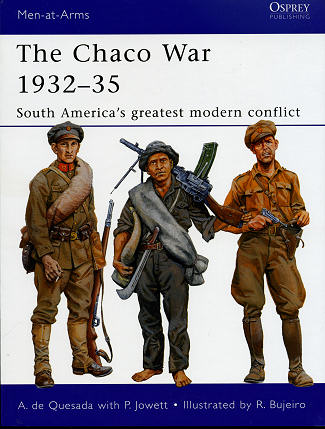 Check on a
map of South America or Google Earth and zoom in on the area that encompasses
the country of Paraguay. You will note that the country is divided into
two major sections. The eastern part with the capital of Asuncion in the lower
western part of that eastern section along the Rio Paraguay. The western half is
basically semi-arid tropical scrub with a distinct wet and dry season. This
western area is part of the Gran Chaco, a large plains area that extends into
Argentina and somewhat into eastern Bolivia. During the 1920s, this area was
claimed by both Bolivia and Paraguay. There were thoughts that this area would
be rich in oil so Bolivia decided to move in.
Check on a
map of South America or Google Earth and zoom in on the area that encompasses
the country of Paraguay. You will note that the country is divided into
two major sections. The eastern part with the capital of Asuncion in the lower
western part of that eastern section along the Rio Paraguay. The western half is
basically semi-arid tropical scrub with a distinct wet and dry season. This
western area is part of the Gran Chaco, a large plains area that extends into
Argentina and somewhat into eastern Bolivia. During the 1920s, this area was
claimed by both Bolivia and Paraguay. There were thoughts that this area would
be rich in oil so Bolivia decided to move in.
The government of Paraguay wanted oil money as well so
moved to stop the Bolivians. Thus began the Chaco War of 1932 to 1935.
This was the first modern war in South America and while
Bolivia had the edge in manpower and in military might, Paraguay had the edge in
leadership. This was one case where inspired generalship was able to overcome a
larger, but less well led army. The Paraguayans also had the benefit of being
more acclimated to the area whereas the Bolivians were equipped for operations
in higher and cooler elevations.
This book covers all the different aspects of the Chaco
War, from the politics, leadership and equipment of both sides to the important
army movements of both sides. During this conflict, both sides used air power,
both in offensive and in support roles. Thanks to an embargo placed on these
countries by the League of Nations, it was difficult but not impossible for both
sides to get equipment. Bolivia had an ally in Chile while Argentina turned a
blind eye to Paraguay's efforts to bring in arms.
To cut to the end, the Paraguayans ended up winning the
war and took over most of the Gran Chaco, leaving Bolivia just a small section.
No oil was ever found in the Paraguayan section while that area held by Boliva
was a major producer. Just goes to show.
Typical of this series, we look at the men and equipment
used by both sides. This includes tanks, aircraft and ships for the Rio Paraguay
is not a small river.
As with all Men-At-Arms titles, this one provides a background to the various
campaigns, has a
look at how the conflicts progressed and were resolved, then takes a closer look
at how these men performed during the various campaigns. Throughout the book are a superb
collection of period photos and illustrations. This is all enhanced more by the superbly
done uniform illustrations that makes this series so popular.
It is another fascinating title and looks at a conflict
few are truly aware took place. It is a very
interesting read and can easily be recommended.
November 2011
For more on the complete line of Osprey books,
visit www.ospreypublishing.com
or contact them at
Osprey Direct at 44-02 23rd St, Suite 219, Long Island City, NY 11101., where you can
get a catalogue of available books.
If you would like your product reviewed fairly and quickly, please
contact
me or see other details in the Note to
Contributors.
 Check on a
map of South America or Google Earth and zoom in on the area that encompasses
the country of Paraguay. You will note that the country is divided into
two major sections. The eastern part with the capital of Asuncion in the lower
western part of that eastern section along the Rio Paraguay. The western half is
basically semi-arid tropical scrub with a distinct wet and dry season. This
western area is part of the Gran Chaco, a large plains area that extends into
Argentina and somewhat into eastern Bolivia. During the 1920s, this area was
claimed by both Bolivia and Paraguay. There were thoughts that this area would
be rich in oil so Bolivia decided to move in.
Check on a
map of South America or Google Earth and zoom in on the area that encompasses
the country of Paraguay. You will note that the country is divided into
two major sections. The eastern part with the capital of Asuncion in the lower
western part of that eastern section along the Rio Paraguay. The western half is
basically semi-arid tropical scrub with a distinct wet and dry season. This
western area is part of the Gran Chaco, a large plains area that extends into
Argentina and somewhat into eastern Bolivia. During the 1920s, this area was
claimed by both Bolivia and Paraguay. There were thoughts that this area would
be rich in oil so Bolivia decided to move in.